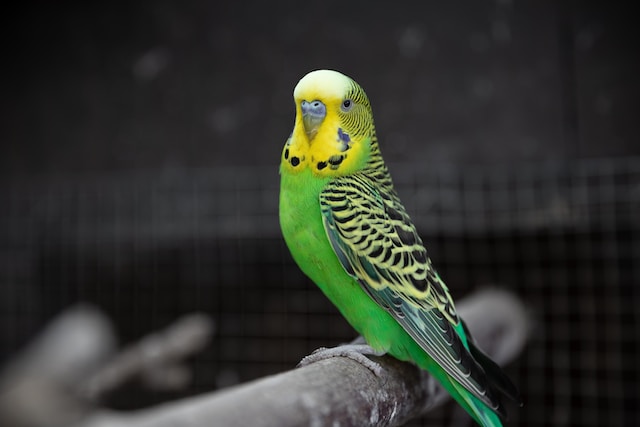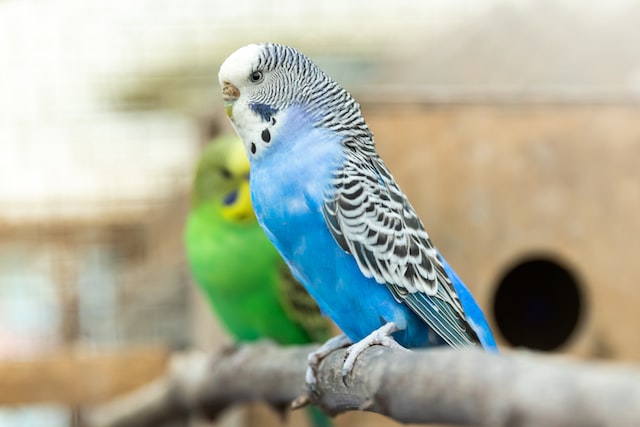Budgie and lovebird are two types of small parrots that are often kept as pets. Lovebirds are native to Africa, while budgies are native to Australia. Lovebirds typically have more colourful plumage than budgies, and they also tend to be more vocal. Budgies are also generally larger than lovebirds.
What is a budgie?
(Photo by Bianca Ackermann on Unsplash )

A budgie, short for budgerigar, is a small parrot species native to Australia. Also known as a common pet parakeet, it is one of the most popular pet birds worldwide. Budgies are known for their vibrant colors, with a variety of hues such as green, blue, yellow, and white. They have a compact size, typically measuring around 18 centimeters in length.
Budgies are highly social and intelligent birds, known for their playful and active nature. They have the ability to mimic human speech and various sounds, making them entertaining companions. Budgies are generally easy to care for, requiring a balanced diet of seeds, fruits, vegetables, and fresh water. They thrive in spacious cages with toys and perches for exercise and mental stimulation.
In the wild, budgies form flocks and feed on grass seeds and grains. They are agile flyers and have a natural inclination for exploration and social interaction. As pets, budgies can develop strong bonds with their owners and exhibit charming personalities, making them a popular choice for bird enthusiasts and families alike.
What is a lovebird?
(Photo by Jonah Pettrich on Unsplash )

A lovebird is a small, social parrot species that is native to Africa. It belongs to the genus Agapornis, which derives its name from the Greek words “agape” (love) and “ornis” (bird), reflecting the affectionate nature and strong pair bonds exhibited by these birds. Lovebirds are popular as pets due to their colorful plumage, playful behavior, and their ability to form deep attachments with their owners.
Lovebirds come in various species, with common ones including the peach-faced lovebird, masked lovebird, and Fischer’s lovebird. They have a stocky build, usually measuring around 13-17 centimeters in length. Lovebirds display vibrant colors, ranging from green, yellow, orange, blue, and combinations thereof, depending on the species and mutations.
In the wild, lovebirds are known for their strong monogamous pair bonds. They often engage in behaviors such as preening, feeding, and vocalizing together, reinforcing their bond. As pets, lovebirds require social interaction and mental stimulation. They thrive when provided with a spacious cage, toys, perches, and a varied diet consisting of seeds, fruits, vegetables, and occasional treats.
Lovebirds are active, curious, and intelligent birds. They can be taught to perform tricks, mimic sounds, and even learn some words. While they may have a tendency to be noisy at times, their playful and affectionate nature makes them popular companions for bird enthusiasts and individuals seeking a devoted avian pet.
Budgie Vs. Lovebird – Key differences
Budgies and lovebirds are both popular pet birds, but they have distinct differences. Here are the key points that set them apart:
Species:
Budgie: Budgie, short for budgerigar, belongs to the species Melopsittacus undulatus. They are native to Australia.
Lovebird: Lovebirds belong to the genus Agapornis, and there are several species within this genus. They are native to Africa.
Size and Appearance:
Budgie: Budgies are slightly larger than lovebirds, typically measuring around 18 centimeters in length. They have a slender body and long tail feathers.
Lovebird: Lovebirds are generally smaller, ranging from 13 to 17 centimeters in length. They have a stockier build and a shorter tail compared to budgies.
Plumage:
Budgie: Budgies come in a wide range of colors, including green, blue, yellow, white, and various combinations. They have distinct markings on their head and wings.
Lovebird: Lovebirds also exhibit vibrant plumage, with colors such as green, yellow, orange, blue, and combinations depending on the species. Each species has its own unique color patterns.
Behavior and Social Needs:
Budgie: Budgies are highly social birds and enjoy interacting with their owners. They can be trained to mimic human speech and various sounds. They are known for their playful and active nature.
Lovebird: Lovebirds are also social birds, but they tend to form strong pair bonds with their mates. They exhibit affectionate behavior towards their partner and may become territorial when nesting. They require social interaction and mental stimulation.
Vocalization:
Budgie: Budgies are known for their diverse vocalizations. They can learn to mimic human speech and various sounds, making them quite vocal and entertaining pets.
Lovebird: Lovebirds have a range of vocalizations that include chirping, squawking, and melodic sounds. They may not have the same speech mimicking abilities as budgies, but they can still produce engaging vocalizations.
Care and Interaction:
Budgie: Budgies are generally easier to care for and can adapt well to different environments. They enjoy flying and should be provided with ample space for exercise.
Lovebird: Lovebirds require social interaction and may become stressed if left alone for long periods. They thrive when provided with companionship, whether it’s from another lovebird or from their human caretaker.
While both budgies and lovebirds are popular pet birds, budgies are larger, more vocal, and highly social, while lovebirds are smaller, known for forming strong pair bonds, and require more social interaction. Understanding these differences can help potential bird owners choose the right pet that aligns with their preferences and lifestyle.
Why you should consider getting a budgie or lovebird
There are several reasons to consider getting a budgie or lovebird as a pet:
Companionship: Budgies and lovebirds are social birds that can form deep bonds with their owners. They enjoy human interaction and can provide companionship and entertainment with their playful and affectionate nature.
Vibrant Colors: Both budgies and lovebirds exhibit vibrant plumage, showcasing a beautiful array of colors. Their colorful appearance adds vibrancy and visual appeal to your living space.
Vocal Abilities: Budgies and lovebirds have the ability to mimic sounds and even learn some words. Their vocalizations can be amusing and entertaining, creating a lively atmosphere in your home.
Compact Size: Budgies and lovebirds are relatively small in size, making them suitable for various living spaces, including apartments or houses with limited space. Their smaller size also makes them easier to handle and care for compared to larger parrot species.
Trainability: Budgies and lovebirds are intelligent birds that can be trained to perform tricks, such as stepping onto your finger or even learning simple commands. Training sessions can provide mental stimulation for both you and your pet.
Low Maintenance: Budgies and lovebirds are generally low-maintenance pets. They require a balanced diet of seeds, fruits, vegetables, and fresh water. Routine cage cleaning and regular interaction are important for their well-being.
Long Lifespan: With proper care, budgies and lovebirds can have a long lifespan. Budgies can live around 5 to 10 years, while lovebirds can live between 10 to 15 years or even longer, depending on the species.
Playful Nature: Budgies and lovebirds are known for their playful behavior. They enjoy toys, perches, and interactive activities, providing you with the opportunity to engage in fun play sessions with your feathered friend.
It’s important to note that owning a budgie or lovebird requires commitment, time, and attention to their needs. Providing a safe and stimulating environment, regular veterinary care, and social interaction are essential for their well-being. Ultimately, the decision to get a budgie or lovebird as a pet should be based on your ability to meet their requirements and provide a loving and nurturing home.
Can you mix budgies and lovebirds?
As we know budgies are much larger than lovebirds and have very different personalities. While budgies are outgoing and social, lovebirds tend to be shy and reserved. This can make it difficult for the two species to get along.
Another important difference is that lovebirds are known to be very territorial, while budgies are not. This means that if you put a lovebird in with a budgie, the lovebird may become aggressive and try to take over the cage. For this reason, it’s generally not recommended to mix these two types of birds.
Photo by Bianca Ackermann on Unsplash








